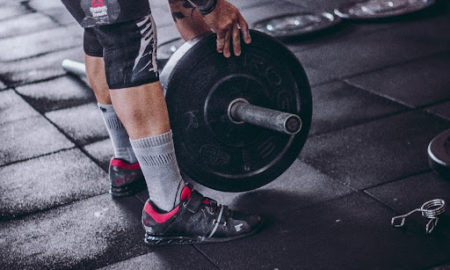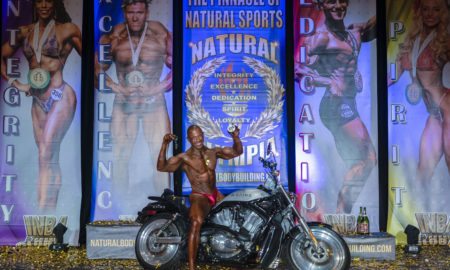If you read my interview with Dave Goodin in the September IRON MAN, you’re probably wondering what all the excitement is about. “What’s this guy talking about—moving both joints at the same time—and what can that do for me, my workouts and my sports performance?”
With the patented Dual Cam Device, New Motion Machines are nothing short of the most significant advance in weight-machine principles since Arthur Jones introduced the spiral cam and revolutionized the weight-training world with his Nautilus machines.
I have the great honor of standing on the shoulders of such giants as Jack LaLanne, who’s credited with having created the first lever and pulley–operated machines; Arthur Jones, who advanced that technology and its principles with his spiral cam; and Steve Holman, who recognized and formulated an advanced system of training, Positions of Flexion, based on the physiology of the human body, its leverage and the sources of resistance available.
To truly understand a problem, and thus its solution, you must understand the subject. Let’s start with biceps.
A properly developed biceps gives an eye-catching sweep to the upper arm when it is extended and can morph into a powerful and impressive ball of steel when contracted. On women it is sexy and strong. On men it speaks of power and confidence. The biceps muscles are so revered in our culture that almost anybody you ask to “make a muscle” will show you biceps.
Part of the mystique and reverence that the arms command come from the fact that you use them for almost everything. You use them to push, pull, hug, pick things up and carry them. Aside from your face, your arms and hands are the most visible and expressive part of your body in day-to-day life. A strong set of arms, male or female, makes an impression.
Biceps Anatomy
Mechanically the biceps are pretty dang cool. They originate at the top and front of the shoulder under the deltoid muscle and then swoop down the front of the upper arm to attach below the elbow.
You also have two additional muscles that lie underneath the biceps, the coracobrachialis and the brachialis. The first attaches to the coracoid process of the shoulder blade and to the front of the humerus. The second connects to the ulna and about half way up the humerus. The coracobrachialis raises the upper arm forward and up. The brachialis is a very strong elbow flexor.
These are all anchored to the bone by Sharpey’s fibers, which are like roots that go down into the bone. When you train, you pull on those fibers, and they react by getting stronger. Logic will tell you that if you train your attachments in different positions and under motion, they will be stronger and more injury resistant.
Working the Biceps and POF
The fact that the biceps group crosses two joints presents some unique challenges when you’re training. In order to work the entire group properly, you must move from a full biceps extension, or stretch, to a full biceps contraction. That places both the elbow and shoulder joints in different positions during the movement.
Steve Holman, IRON MAN’s editor in chief, has been talking about this brilliant concept for more than 20 years. He coined the term “Positions of Flexion” to convey the importance of working a muscle through its full range of motion with full resistance.
A typical POF biceps workout would consist of barbell curls for the midrange positions, incline curls for the stretch position and concentration curls for the contracted position. You can substitute exercises for the designated one in each position. For example, you could use preacher curls instead of barbell or dumbbell curls and overhead cable curls instead of concentration curls.
The reason for the variation is to place the shoulder in different positions so the upper attachments of the biceps group are at a different position in their range of motion, or flexion. During the contraction, however, the upper attachments are not in motion, and only the elbow is being moved.
The different positions are necessary because with free weights the resistance is always pulled straight down by gravity. The most resistance occurs when your forearm is parallel to the floor and the least when your forearm is in line with gravity.
You can work around that limitation a bit by using cables that redirect gravity with a pulley. Resistance is still in a straight line with the cable.
Machines have managed to redirect resistance into an arc, or curve, so you can keep resistance around a single pivot point, the elbow. The problem is, the biceps muscles don’t act around a single pivot point. Their true and natural full motion involves moving around two pivot points, the elbow and the shoulder, at the same time.
The Future of Resistance Training
In the early 1970s Arthur Jones, who had developed the Nautilus system, stated in this very magazine: “Obviously I cannot predict the discoveries of the future, and I certainly don’t pretend to be able to, but in this instance, just as obviously, I don’t have to predict the future. All—and I mean all—of the important problems connected in the field of weight training have now been solved.”
I have immense respect for Arthur Jones. Without his innovation we wouldn’t have the amazing machines we have today and probably wouldn’t have the level of advancement in sports performance. We wouldn’t have such widespread interest in physical fitness and physical culture. Arthur Jones expanded weight training from a curiosity in the gritty gyms of the ’60s and ’70s into the advanced principles and machines used in gyms, fitness centers and with sports teams around the world today.
But Jones was wrong!
One of his gifts was his genius for publicity. I don’t know if he was trying to stir controversy or actually believed that all major problems in weight training had been solved, but what he said was wrong.
The dilemma of how to train the muscle groups that cross two joints had been addressed with multiple exercises and the Positions-of-Flexion model, but the problem had not been solved.
Blasting Your Biceps With New Motion Machines and POF
Now the problem is solved. The patented mechanism of New Motion Machines enables you to condense all of the positions of flexion into one fluid motion. By taking one cam or wheel and attaching it to the frame of the machine, then attaching a second cam or wheel to the first, you create a dual-pivot system. When you rotate the second cam, you must rotate it around the first. That’s exactly like your biceps motion during their full contraction!
Imagine starting with a standing cable curl facing away from the machine so the tension is pulling from behind you. Move into a preacher curl, followed by a standing curl and then a concentration curl, and finish with an overhead cable curl. That’s a lot of work to hit every angle.
Now, imagine that you can move through all of those positions in one single fluid repetition. How much effort and energy could you dump into a set like that? How much more work per repetition could you accomplish with total resistance all the way through your entire range of biceps contraction? How much more muscle fiber recruitment would occur? How much blood and O2 are you going to have to pump to accomplish that?
Most important, how are your biceps going to respond to full-range-of-motion, full-resistance movement on the New Motion Machines?
I can promise you as a doctor of chiropractic and a longtime gym rat that New Motion Machines biceps movement will blast your biceps in a totally new way. You’ll breathe harder. You’ll burn out faster. You’ll feel the resistance from top to bottom. You’ll walk away from your first session with a deep, full fatigue in your biceps. It feels like a long day’s work in the summer sun. Exhausting.
A typical POF biceps workout would have you doing three exercises for two to four sets of about 10 reps each. That’s between 60 and 200 repetitions—each exercise hitting a different “angle” of the biceps.
I recommend that in your first few biceps sessions on the New Motion Machine you warm up with a set or two of standing barbell or dumbbell curls. It’s what you’re used to and the way gravity works with your biceps.
Now for the fun stuff. Find your position on the New Motion Machine, sitting slightly forward on the seat. Choose a light weight to learn the machine, and perform one set. Then add a bit of weight for your next set. As you engage the weight, you’ll feel the biceps kick in immediately, and as you squeeze the biceps, the machine will move with you. You do not have to lift the machine. In fact, you can’t cheat. It won’t let you. You must contract the biceps to move the resistance and use your entire biceps complex. You must use more energy to do each rep and travel through every position of flexion just to do the movement. You’ll get stronger. You’ll be better able to resist injury. And you’ll grow.
Here’s what IFBB pro Dave Goodin had to say after being pushed to the limit for three sets of 10 reps: “Your biceps will be talking to you for days. They’ll say, ‘Holy crap, dude! What did you do to me?’”
The answer: “New Motion Machines.” The game has changed. Get used to it and grow.
Editor’s note: Kurt Edeker D.C., is a father of three, husband, inventor and chiropractor in Austin, Texas. For more information visit www.NewMotionMachines.com. IM
















You must be logged in to post a comment Login